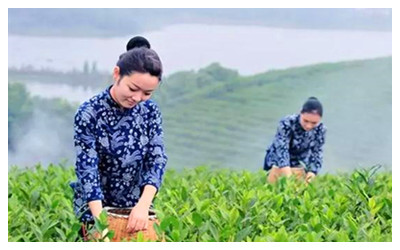
Chinese Tea Picking
The tea is a kind of small shrubs tree with tender and glabrous branches. Its leaves are leathery, oblong or oval. And its flowers are white which blooming period is from October to February of the following year. Tea grows to bear capsules fruits with 3 spherical or 1-2 spherical.
Tea Planting
The method of planting tea trees is to propagate the seeds first and then plant them in the tea gardens. For the fertilization of tea gardens, soya-bean cakes or other varieties of organic manure are generally used, and seldom chemical fertilizers. When pests are discovered, the affected plants will be removed to prevent their spread, and also to avoid the use of pesticides.
A new tea plant must grow for five years before its leaves can be picked and, at 30 years of age, it will be too old to be productive. The trunk of the old plant must then be cut off to force new stems to grow out of the roots in the coming year. By repeated rehabilitation in this way, a plant may serve for about l00 years.
Tea Picking
 The season of tea picking depends on local climate and varies from area to area. Usually, tea picking starts from the end of March and lasts through October, altogether 20-30 times from the same plants at intervals of seven to ten days. With a longer interval, the quality of the tea will deteriorate.
The season of tea picking depends on local climate and varies from area to area. Usually, tea picking starts from the end of March and lasts through October, altogether 20-30 times from the same plants at intervals of seven to ten days. With a longer interval, the quality of the tea will deteriorate.
The best tea is gathered several days before Qingming Festival ( 5th solar term) when new twigs have just begun to grow and carry "one leaf and a bud." To make one kilogram (2.2 lbs) of finished tea, 60,000 tender leaves have to be plucked. In the old days, this grade tea was meant solely for the imperial household; it was, therefore, known as "tribute tea".
Tea Planting
The method of planting tea trees is to propagate the seeds first and then plant them in the tea gardens. For the fertilization of tea gardens, soya-bean cakes or other varieties of organic manure are generally used, and seldom chemical fertilizers. When pests are discovered, the affected plants will be removed to prevent their spread, and also to avoid the use of pesticides.
A new tea plant must grow for five years before its leaves can be picked and, at 30 years of age, it will be too old to be productive. The trunk of the old plant must then be cut off to force new stems to grow out of the roots in the coming year. By repeated rehabilitation in this way, a plant may serve for about l00 years.
Tea Picking
 The season of tea picking depends on local climate and varies from area to area. Usually, tea picking starts from the end of March and lasts through October, altogether 20-30 times from the same plants at intervals of seven to ten days. With a longer interval, the quality of the tea will deteriorate.
The season of tea picking depends on local climate and varies from area to area. Usually, tea picking starts from the end of March and lasts through October, altogether 20-30 times from the same plants at intervals of seven to ten days. With a longer interval, the quality of the tea will deteriorate.The best tea is gathered several days before Qingming Festival ( 5th solar term) when new twigs have just begun to grow and carry "one leaf and a bud." To make one kilogram (2.2 lbs) of finished tea, 60,000 tender leaves have to be plucked. In the old days, this grade tea was meant solely for the imperial household; it was, therefore, known as "tribute tea".
A skilled woman picker can only gather 600 grams (a little over a pound) of green tea leaves in a day.The new leaves must be parched in tea cauldrons. This work, which used to be done manually, has been largely mechanized.
For the processes of grinding, parching, rolling, shaping and drying other grades of tea various machines have been developed and built, turning out about 100 kilograms of finished tea an hour and relieving the workers from much of their drudgery.







 Ask Questions ?
Ask Questions ?